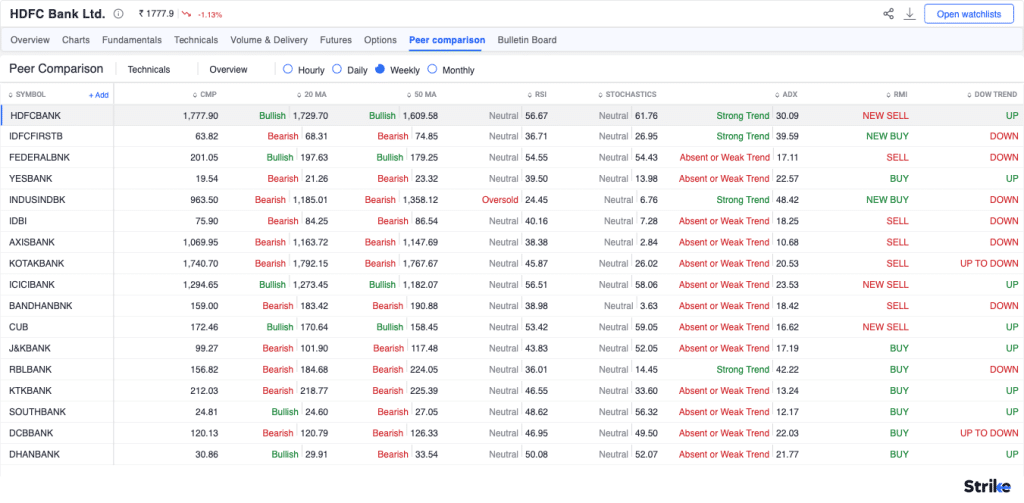Best Banking Sector Stocks to Invest in Dec, 2025
Here is a list of top banking sector stocks with their corresponding data. These banking sector stocks are compared against their share price, change %, dow trend, volume, 52 week range, returns, p/e ratio, p/bv ratio & market cap.
| Stock Name | Share Price | Change % | Buy/Sell | Dow Trend | Volume | 52 Week Range | 1M Return | 3M Return | 6M Return | 1Y Return |
|---|---|---|---|---|---|---|---|---|---|---|
| KTKBANK | 206.47 2.22 | 1.09% | 21,81,930 | 162.20 231.00 | 16.33% | 15.51% | -1.64% | -9.57% | ||
| FEDERALBNK | 261.50 1.90 | 0.73% | 27,18,884 | 172.66 263.20 | 10.86% | 32.98% | 25.65% | 21.81% | ||
| AUBANK | 975.85 -17.85 | -1.80% | 11,43,450 | 478.35 1007.25 | 9.72% | 37.26% | 26.09% | 65.37% | ||
| KOTAKBANK | 2,187.30 57.80 | 2.71% | 34,77,088 | 1723.75 2301.90 | 4.81% | 10.90% | 1.96% | 21.88% | ||
| CANBK | 146.98 1.42 | 0.98% | 1,35,02,895 | 78.60 154.21 | 4.34% | 31.15% | 25.53% | 35.15% | ||
| UJJIVANSFB | 53.24 0.04 | 0.08% | 43,84,280 | 30.88 56.30 | 4.33% | 12.70% | 8.63% | 45.94% | ||
| AXISBANK | 1,273.20 -5.40 | -0.42% | 11,71,283 | 933.50 1304.00 | 4.15% | 17.09% | 3.39% | 10.98% | ||
| SOUTHBANK | 39.75 0.69 | 1.77% | 1,69,41,116 | 22.30 41.65 | 2.53% | 37.02% | 29.10% | 52.36% | ||
| SURYODAY | 136.00 2.30 | 1.72% | 1,57,106 | 97.97 161.48 | 1.93% | 5.80% | -9.60% | -10.69% | ||
| EQUITASBNK | 59.39 -0.32 | -0.54% | 17,28,790 | 50.00 75.50 | 1.80% | 9.52% | -14.20% | -7.68% | ||
| TMB | 512.65 16.30 | 3.28% | 1,13,861 | 401.00 557.00 | 1.72% | 18.72% | 11.92% | 2.78% | ||
| INDUSINDBK | 836.05 2.20 | 0.26% | 19,71,135 | 606.00 1086.55 | 1.20% | 11.68% | -0.03% | -15.11% | ||
| SBIN | 963.20 3.45 | 0.36% | 35,15,129 | 680.00 999.00 | 1.04% | 16.94% | 18.18% | 11.79% | ||
| DCBBANK | 169.66 -0.18 | -0.11% | 4,42,829 | 101.41 190.50 | 0.77% | 34.07% | 16.27% | 30.21% | ||
| HDFCBANK | 998.00 8.20 | 0.83% | 75,09,889 | 812.15 1020.50 | 0.64% | 3.12% | 2.34% | 7.13% | ||
| MAHABANK | 57.40 0.68 | 1.20% | 88,67,483 | 42.00 61.56 | 0.54% | 5.09% | 2.57% | 1.74% | ||
| CUB | 261.85 -2.90 | -1.10% | 4,02,538 | 142.91 284.00 | 0.36% | 29.85% | 30.96% | 40.89% | ||
| ICICIBANK | 1,358.80 -4.80 | -0.35% | 41,13,394 | 1186.00 1500.00 | 0.04% | -3.05% | -5.05% | 2.36% | ||
| IDFCFIRSTB | 80.56 0.24 | 0.30% | 1,06,52,910 | 52.46 82.70 | -0.16% | 11.21% | 12.99% | 23.56% | ||
| BANKBARODA | 285.30 -0.80 | -0.28% | 59,07,145 | 190.70 303.95 | -0.19% | 19.74% | 17.61% | 9.41% | ||
| FINOPB | 267.60 1.10 | 0.41% | 2,28,386 | 200.00 366.55 | -1.13% | -5.02% | -0.31% | -22.14% | ||
| UNIONBANK | 150.50 2.44 | 1.65% | 44,40,233 | 100.81 160.15 | -1.39% | 12.55% | -1.52% | 16.50% | ||
| KARURVYSYA | 241.52 0.40 | 0.17% | 2,90,305 | 154.56 258.50 | -1.75% | 15.22% | 20.99% | 21.42% | ||
| CAPITALSFB | 266.00 -1.05 | -0.39% | 21,144 | 250.00 330.65 | -2.12% | -9.51% | -12.79% | -4.32% | ||
| CENTRALBK | 36.52 0.32 | 0.88% | 31,25,994 | 32.75 60.15 | -3.08% | 0.47% | -9.00% | -38.09% |
List of Top Banking Sector Stocks
1 . Karnataka Bank Ltd.
Karnataka Bank Ltd. is currently trading at ₹206.47. It has a daily trading volume of 21,81,930. Karnataka Bank Ltd. touched a 52-week high of ₹231.00, while the 52-week low stands at ₹162.20. While Nifty delivered 0.62% return over the 1 year, Karnataka Bank Ltd. underperformed with a -9.57% return.
2 . Federal Bank Ltd.
Federal Bank Ltd. is currently trading at ₹261.50. It has a daily trading volume of 27,18,884. Federal Bank Ltd. touched a 52-week high of ₹263.20, while the 52-week low stands at ₹172.66. While Nifty delivered 0.62% return over the 1 year, Federal Bank Ltd. outperformed with a 21.81% return.
3 . Au Small Finance Bank Ltd.
Au Small Finance Bank Ltd. is currently trading at ₹975.85. It has a daily trading volume of 11,43,450. Au Small Finance Bank Ltd. touched a 52-week high of ₹1,007.25, while the 52-week low stands at ₹478.35. While Nifty delivered 0.62% return over the 1 year, Au Small Finance Bank Ltd. outperformed with a 65.37% return.
4 . Kotak Mahindra Bank Ltd.
Kotak Mahindra Bank Ltd. is currently trading at ₹2,187.30. It has a daily trading volume of 34,77,088. Kotak Mahindra Bank Ltd. touched a 52-week high of ₹2,301.90, while the 52-week low stands at ₹1,723.75. While Nifty delivered 0.62% return over the 1 year, Kotak Mahindra Bank Ltd. outperformed with a 21.88% return.
5 . Canara Bank
Canara Bank is currently trading at ₹146.98. It has a daily trading volume of 1,35,02,895. Canara Bank touched a 52-week high of ₹154.21, while the 52-week low stands at ₹78.60. While Nifty delivered 0.62% return over the 1 year, Canara Bank outperformed with a 35.15% return.
6 . Ujjivan Small Finance Bank Ltd.
Ujjivan Small Finance Bank Ltd. is currently trading at ₹53.24. It has a daily trading volume of 43,84,280. Ujjivan Small Finance Bank Ltd. touched a 52-week high of ₹56.30, while the 52-week low stands at ₹30.88. While Nifty delivered 0.62% return over the 1 year, Ujjivan Small Finance Bank Ltd. outperformed with a 45.94% return.
7 . Axis Bank Ltd.
Axis Bank Ltd. is currently trading at ₹1,273.20. It has a daily trading volume of 11,71,283. Axis Bank Ltd. touched a 52-week high of ₹1,304.00, while the 52-week low stands at ₹933.50. While Nifty delivered 0.62% return over the 1 year, Axis Bank Ltd. outperformed with a 10.98% return.
8 . South Indian Bank Ltd.
South Indian Bank Ltd. is currently trading at ₹39.75. It has a daily trading volume of 1,69,41,116. South Indian Bank Ltd. touched a 52-week high of ₹41.65, while the 52-week low stands at ₹22.30. While Nifty delivered 0.62% return over the 1 year, South Indian Bank Ltd. outperformed with a 52.36% return.
9 . Suryoday Small Finance Bank Ltd.
Suryoday Small Finance Bank Ltd. is currently trading at ₹136.00. It has a daily trading volume of 1,57,106. Suryoday Small Finance Bank Ltd. touched a 52-week high of ₹161.48, while the 52-week low stands at ₹97.97. While Nifty delivered 0.62% return over the 1 year, Suryoday Small Finance Bank Ltd. underperformed with a -10.69% return.
10 . Equitas Small Finance Bank Ltd.
Equitas Small Finance Bank Ltd. is currently trading at ₹59.39. It has a daily trading volume of 17,28,790. Equitas Small Finance Bank Ltd. touched a 52-week high of ₹75.50, while the 52-week low stands at ₹50.00. While Nifty delivered 0.62% return over the 1 year, Equitas Small Finance Bank Ltd. underperformed with a -7.68% return.
| Companies | Return % |
|---|---|
| KTKBANK | 16.33% |
| FEDERALBNK | 10.86% |
| AUBANK | 9.72% |
| KOTAKBANK | 4.81% |
| CANBK | 4.34% |
Upgrade Your Toolkit
Access powerful tools for smarter, data-driven stock analysis.
Which Factors Affect Bank Share Price?
The bank share price is influenced by factors including interest rates, RBI policies, and broader economic conditions. These elements shape the profitability, risk perception, and market sentiment surrounding banking stocks.
Interest rates play a pivotal role in determining bank stock performance. Banks earn revenue primarily through the difference between lending rates and deposit rates, known as the net interest margin. When interest rates rise, banks can often charge higher rates on loans, potentially increasing their income. However, rising rates may also dampen loan demand and increase defaults, negatively impacting profitability. Conversely, lower interest rates reduce borrowing costs for consumers and businesses, boosting loan demand and economic activity but compressing banks’ profit margins. Additionally, higher interest rates tend to decrease the attractiveness of equities as investors shift to fixed-income securities, which can lead to a decline in bank stock prices.
The Reserve Bank of India’s (RBI) monetary policies significantly impact banking stocks. For instance, changes in the repo rate—the rate at which the RBI lends to commercial banks—affect banks’ cost of funds. A hike in the repo rate typically increases borrowing costs for banks, leading to higher lending rates but potentially reducing credit growth. On the other hand, accommodative measures like a reduction in the Cash Reserve Ratio (CRR) or repo rate can infuse liquidity into the banking system, encouraging lending and boosting bank profitability. Regulatory policies regarding capital requirements and asset quality also influence investor sentiment toward bank stocks.
The overall health of the economy is another crucial determinant of bank share prices. During periods of robust economic growth, increased business activity drives higher demand for loans, improving banks’ earnings. Conversely, economic slowdowns or recessions can lead to reduced credit demand and higher non-performing assets (NPAs), negatively affecting profitability. Inflation levels also play a role; high inflation may prompt tighter monetary policy (e.g., higher interest rates), which could strain borrowers and impact banks’ asset quality.
Investors must monitor these factors closely as they directly influence banks’ profitability, growth prospects, and risk exposure.
How to Choose the Best Bank Stocks?
To choose the best banking stocks, we will analyse fundamental and technical parameters and data using strike.money.
First step before choosing the best bank stocks is to analyze the technical parameters of banking stocks like HDFC Bank and its peers or competitors functioning in the banking sector.
We will go through 8 data points on a Weekly Time frame and study the readings of 20 MA, 50 MA, RSI, Stochastics, ADX, Rohit Momentum Indicator (RMI) and Dow Trend.

HDFC Bank has maintained a bullish trend on 20 and 50-day moving averages on its weekly time frame. At the same time, RSI and stochastic indicators, which are momentum oscillators, also suggest neutral characteristics. HDFC Bank is the only bank that is showing ‘Strong Trend’ readings on the ADX indicator. Except for RMI, even the Dow Trend indicator is showing an ‘UP’ move.
The second step before selecting a banking stock is to analyse the fundamental data points of these stocks.
HDFC Bank, its peers, and the overview of their major fundamental data points like Market Cap, PE ratio, dividend yield, ROE, ROA, NIM, PBV, and CASA are studied.
Study the image above.
HDFC Bank is a large-cap stock and contains the highest market cap.
The stock’s healthy PE ratio of 20.83 suggests that the bank continues its historical growth trajectory. The return on equity (ROE) of HDFC Bank is around 14.62, which is considered quite healthy as its peers also have similar figures.
A PBV of 3.14 for HDFC Bank is good, particularly given the bank’s strong financial track record, profitability, and market leadership. It is slightly higher than its peers, reflecting the market’s confidence in its future growth.
Which Bank Stocks are Best to Buy?
Below is the list of top 10 bank stocks based on Marketcap & reason why they are good to buy.
| Bank Name | Market Position | Financial Performance | Growth Potential |
| HDFC Bank | India’s largest private sector bank by assets and the world’s tenth-largest bank by market capitalization, with a market cap of approximately ₹14 trillion, making it the third-largest company on the Indian stock exchanges. | Consolidated profit after tax of ₹18,627.44 crore for the quarter ending September 30, 2024, with total income of ₹121,456.74 crore, reflecting strong growth. | HDFC Bank’s Digital 2.0 initiative aims to enhance customer experience and expand service offerings, alongside strategic investments in technology and infrastructure to support future growth. |
| ICICI Bank | Second largest bank in India by market capitalization, with a market cap of over ₹9 trillion, making it the fourth largest listed company in India. | Consolidated profit after tax of ₹12,948 crore for Q2 FY24-25, an 18.8% year-on-year growth. Revenue for the same quarter was ₹15,490 crore, marking a 13.5% increase. | Focusing on digital transformation, expanding retail banking services, and enhancing customer engagement to drive future growth. |
| State Bank of India | Fifth largest firm in India by market capitalization, valued at ₹6.89 lakh crore. | Net profit of ₹18,331 crore for Q2 FY25, a 27.92% increase year-on-year, with total income of ₹1,29,141 crore for the quarter. | Plans to open 400 new branches in FY25 and significant investments in digital banking initiatives, including the YONO platform with over 68 million customers. |
| Kotak Mahindra Bank | Ranked 19th by market capitalization with ₹3,49,419 crore; topped S&P Global ranking for financial performance among Indian banks. | Standalone net profit of ₹13,782 crore (up 26% YoY) and consolidated profit of ₹18,213 crore (up 22% YoY) for FY24; net interest income of ₹36,000 crore. | Plans to open 175-200 new branches in FY25 and aims to triple its corporate client base through enhanced digital channels. |
| Axis Bank | Third largest private sector bank in India by assets and fourth largest by market capitalization, with a market cap of approximately ₹3.6 trillion as of December 2024. | Net profit of ₹24,861 crores for FY24, a 160% increase year-on-year; operating revenue of ₹72,336 crores, a 22% increase. | Axis Bank is enhancing its digital capabilities with initiatives like ‘open by Axis Bank’, a digital banking platform, and UPI-ATM for cardless transactions, positioning itself for future growth. |
| IndusInd Bank | Market cap of ₹77,814 crores, ranked 134th in India by market capitalization. Competitive advantages include strong brand presence and diversified product offerings. | Net profit of ₹8,977 crores for FY24, up 21% YoY. Net interest income grew by 15% YoY to ₹5,376 crores. | Focus on digital transformation with initiatives like digital banking units and partnerships for enhanced services. Expected revenue growth of 21.2% annually over the next three years due to lower interest rates and increased loan demand. |
| Bank of Baroda | 6th largest bank in India by market capitalization with a market cap of ₹1.36 trillion. | Net profit of ₹5,238 crore for Q2 FY25, a 23.2% increase YoY. Total revenue for FY24 was ₹1,41,779 crore, with a net interest income of ₹11,622 crore for Q2 FY25. | Plans to double its business to ₹48 lakh crore in five years, focusing on retail, agriculture, and MSME sectors, and expanding its branch network by opening 600 new branches. |
| Punjab National Bank | Third largest public sector bank in India with a market share of approximately 5.8% and a market capitalization of around ₹1.25 trillion. | Net profit increased by 145% year-on-year to ₹4,303 crore for Q2 FY25, with net interest income of ₹10,517 crore, reflecting a growth of 5.99% year-on-year. | Forecasted revenue growth of 12.9% per annum and earnings growth of 9% per annum, with ongoing digital initiatives to enhance customer experience and asset quality. |
| Union Bank of India | Ranked 102 by market capitalization with a market cap of ₹98,839 crore. Competitive advantages include a strong presence in the agriculture sector and a focus on customer satisfaction. | Net profit of ₹4,720 crore for Q2 FY25, a 34% year-on-year increase. Revenue for FY24 was ₹99,778 crore, showing a growth of 2.78%. | Plans to invest ₹1,000 crore in technology over two years, focusing on digital transformation initiatives like ‘Union SAMBHAV’ and ‘UNIONNXT’. |
| Canara Bank | Market capitalization of approximately ₹991.60 billion; strong market position due to extensive branch network and customer-centric approach. | Net profit of ₹3,757 crore for FY 2023-24, reflecting an 18.33% year-on-year growth; total revenue of ₹139,165 crore. | Focusing on expanding branch network, enhancing digital banking initiatives, and increasing share of high-yielding retail, agriculture, and MSME assets. |
Why Should You Invest in Banking Stocks?
Investing in banking stocks is a compelling opportunity due to their potential for stable returns, long-term growth, and diversification benefits.
Many banks have a strong track record of paying reliable dividends, supported by predictable cash flows from lending and investment activities. For instance, large-cap banks in India have consistently delivered dividend yields ranging from 2% to 4% annually. Additionally, the sector benefits from India’s expanding economy, with GDP growth projected at 6-7%, creating opportunities for banks to grow their loan portfolios and customer base.
Also, Indian banks have witnessed robust earnings momentum due to improved credit growth and asset quality. Analysts predict returns of 24% to 44% for select banking stocks over the next year, reflecting strong market confidence. Furthermore, digital transformation and financial inclusion initiatives are enabling banks to tap into new markets, enhancing their profitability.
The Reserve Bank of India (RBI) ensures a stable regulatory environment, fostering investor confidence. Recent measures to improve liquidity and ease deposit growth concerns have strengthened the sector’s outlook. With balance sheets at their strongest in decades, banks are well-positioned to weather economic challenges.
The Best Trading App Forever
Maximise your potential investment with our all-in-one tool
Start Your 7-Day Free Trial

